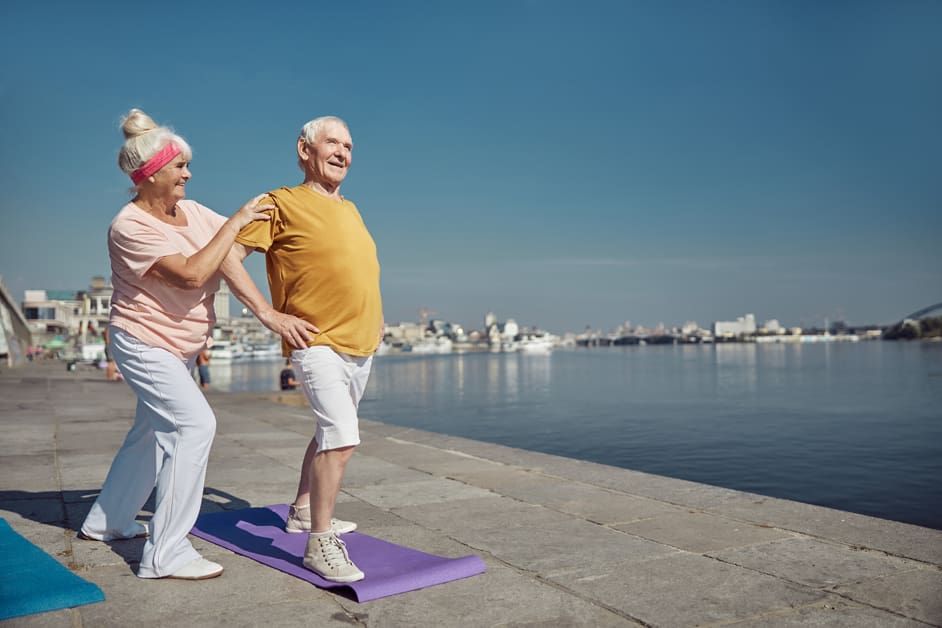Introduction
Knee osteoarthritis is a common issue that brings pain and makes daily tasks difficult. So, warming up is an essential tool for managing it. Let’s explore the perks and how to create a successful warm-up routine.
Benefits include: feeling better, less risk of injury and improved performance.
To make a good warm-up routine, start with light exercises, stretch and end with dynamic movements.
What is knee osteoarthritis?
Knee osteoarthritis is a type of arthritis that affects the joints in the knee area. It occurs when the protective cartilage on the ends of bones wears wears down, causing bones to rub against each other. This produces inflammation and pain in the joint, leading to stiffness, decreased range of motion and difficulty performing everyday tasks.
It is most common in people over 50 years old. But, younger people can also develop it from an injury or from being very active.
The cause is unknown, but likely due to
- genetics
- lifestyle
- previous injuries
Treatment is based on
- lifestyle modifications
- medications
- injections
- surgery
Benefits of warm-up routines
Warm-up routines are great for those with knee osteoarthritis. They can help reduce pain, improve flexibility and motion, strengthen joints and muscles, and lower the risk of harm. Plus, you’ll be aware of your body’s posture and balance during activities, thus improving your coordination.
Before any physical task, warm-up reducing stress on the joints. This helps lower inflammation post-activity. Your muscles are also able to stretch more, which lowers the possibility of muscle tears.
A warm-up should include:
- Aerobic exercise (e.g. walking or biking) to raise your heart rate and break a sweat.
- Dynamic stretching (arm circles or leg swings).
- Core exercises (planks or bridges).
- Low-impact strength training (wall pushups or calf raises).
Tailor it to your condition for the best results and to avoid injury.
Warm-up Routine
Suffer from knee osteoarthritis? Warming up is key! It can help reduce inflammation and pain. It can give you more flexibility and range of motion, and lower the risk of injury.
So, what kind of warm-up exercises are good for people with knee osteoarthritis? Check out this article to find out! Get the most out of your physical activity with the right warm-up.
Low-impact cardio
Warm-up routines are a must for people with knee osteoarthritis. They help reduce the risk of injury and aid recovery. Low-impact cardio is a great warm-up option. It’s perfect for reducing joint stress. Both indoor and outdoor activities can be part of your routine.
At home, start with some light stretching. Move each joint through its full range of motion. Then, do some light aerobic exercises like marching, chair exercises and dynamic movements like tai chi or qigong. If you’re walking outside, pick a flat surface with soft ground.
Indoor machines like stationary bikes are great low-impact cardio options. Cycling indoors works the quadriceps and hip flexors while relieving pressure on the knee joint. An elliptical machine is another good heart-pumping option. It doesn’t put extra weight on the knees and hips.
Start slowly and gradually increase intensity over time. Listen to your body and rest if needed. Safety first when preventing OA flareups!
Stretching
Stretching is crucial in any warm-up routine, especially for people with knee OA. It reduces stiffness and pain.
Focus on the muscles near the affected joint, as well as other muscles close to stiff or inactive joints.
Start with dynamic stretching exercises. Move stretches such as arm circles or walking lunges warm the body up for a more intense workout or activity.
Static stretches are great for OA knees. They increase flexibility in stiff areas like the quadriceps, hamstrings, calf muscles and hip flexors. Do each stretch slowly and gently for 45 seconds then release it. Be careful not to cause further injury.
Leg swings can also help activate surrounding muscle groups. They improve strength and range of motion in your hips, ankles, and knees – but avoid putting pressure into your affected joint(s).
Strengthening exercises
A proper warm-up routine must include exercises that strengthen major muscle groups. These exercises help the body get ready for activity, increase blood/oxygen flow, raise core body temperature, and reduce the chance of injury.
Here are some exercises you can do to prepare your body:
- Squats: With feet hip-width apart and back straight, lower yourself using glutes and quads.
- Lunges: Keep torso vertical and shoulders upright. Step forward with one leg and lower the other in a lunge position. Alternate legs through sets.
- Crunches: Lie on floor. Bend knees in table top position. Crunch up using abdominal muscles. Don’t pull on neck/head.
- Planks: Start in push up position with elbows under shoulders. Keep abs tight. Hold for 10 seconds. Work up to 1 minute.
- Arm circles/swings: Extend arms side to side. Move shoulder joints in dynamic motion. Do 5 forward, 5 backward per set (2 sets).
Tips for People with Knee Osteoarthritis
Knee osteoarthritis is a chronic and progressive issue. It causes pain and troubles in movement, due to the breakdown of joint cartilage. There is no cure, but ways to manage it exist! Doing warm-up exercises before physical activity can help reduce the pain and stiffness. Here are tips and exercises that may prove useful:
- Stretch your hamstrings, quadriceps, and hip muscles before and after physical activity.
- Do low-impact aerobic activities such as swimming, biking, and walking.
- Try strength training exercises to help build up muscles around the affected joint.
- Practice balance exercises to reduce the risk of falls.
- Avoid high-impact activities such as running and jumping.
Wear appropriate footwear
Wearing suitable shoes is key for those with knee osteoarthritis during a warm-up. The shoe must offer support and cushioning to decrease strain on the knee. Shoes with arch shift materials spread force over the foot, lessening stress on the knees. Opt for shoes with rigid soles for extra support, and high-top running shoes are often recommended.
Additionally, choose shoes that are worn in but still in good condition. Lace them up securely to ensure proper fit and to prevent injury and discomfort in the knee during exercise.
Use a foam roller
Foam rollers are a great way to reduce tension in muscles, tendons, and ligaments around the knee. They can also help with stiffness and pain from knee osteoarthritis.
Begin with a slow, gentle rolling motion from your ankle to your thigh. Then repeat on the other leg. Focus on specific points where tightness is felt. Move up and down the length of the leg multiple times until relief is experienced.
Be mindful that foam rolling can increase discomfort if done too strongly, so approach this exercise carefully. You can use a foam roller on other major muscle groups too. Glutes, hamstrings, quads and even your lower back can be targeted. All of these areas can affect how well you can handle standing and walking with osteoarthritis pain.
Use a heat pack
Heating the knee can be useful for those with OA. A heat pack can help reduce stiffness and pain. Different models are available, so it’s wise to consult a healthcare provider first.
The heat pack should be used after stretching and strengthening exercises or before physical activities. For instance, during walking or when resting. However, no more than 30 minutes should be used at a time. Too much heat can cause inflammation and discomfort. Pressure should also be avoided to prevent aggravating any existing pain.
Conclusion
Consideration of all evidence points to the conclusion that it is vital for those with knee osteoarthritis to include warm-up routines as a component of their rehabilitation. Dynamic stretching, muscle-strengthening exercises and aerobic activity should be the focus of such activities. These activities should be tailored to the individual’s strength and mobility levels and monitored carefully by a doctor to guarantee secure and favorable results.
Summary of benefits
Warm-up routines are essential for people with knee osteoarthritis. They can reduce injury risk, pain, stiffness, and increase range of motion. Plus, they’re quick; just 5-10 minutes daily.
Choose exercises like static stretching, dynamic stretching, foam rolling, or activities like walking, swimming, or biking. Make sure your routine is tailored to your needs.
By following a warm-up routine each day, people with knee osteoarthritis can reduce their symptoms and improve their quality of life.
Final thoughts
Warm-up routines are great for avoiding injury and boosting performance. Especially for those with osteoarthritis of the knees, warming up is essential. Plus, it can help reduce pain and stiffness connected to this condition.
- Begin slowly, then pick up the intensity.
- Stretch for 5-10 minutes, and include dynamic movements like walking, jogging or cycling.
- When your muscles are warm, static stretches can help improve flexibility in stiff spots.
Don’t let knee osteoarthritis stop you from being active! Create a warm-up plan that works for you, and you’ll get the most out of exercising while reducing the effects of the condition.
Frequently Asked Questions
Q: What are warm-up routines for people with knee osteoarthritis?
A: Warm-up routines for people with knee osteoarthritis can include light jogging, knee bends, and range of motion exercises. The goal of these exercises is to increase blood flow to the joints and reduce stiffness. Stretching the quadriceps and hamstrings can also help reduce pain and improve range of motion.
Q: How often should I do warm-up routines for people with knee osteoarthritis?
A: It is recommended to do warm-up routines for people with knee osteoarthritis three times a week. However, if you experience pain or discomfort during the exercises, reduce the frequency or intensity of the exercises. It is also important to speak with your doctor or physical therapist before starting any exercise routine.
Q: What types of exercises should I avoid if I have knee osteoarthritis?
A: Exercises that involve high-impact activities, such as running, jumping, and twisting should be avoided if you have knee osteoarthritis. It is also important to avoid exercises that are too strenuous or cause pain. Instead, focus on exercises that increase flexibility, range of motion, and strength.





